|
RE: The Importance Of Knowing What Your Spark Plugs Can Tell You
Catalytic-Converter Damaging Misfires: On modern engines with computer-controlled ignition systems and onboard diagnostics, certain types of misfires will trip the Malfunction Indicator Light (MIL – also called a check engine light). The driver may experience a rough idle, sluggish performance and/or poor fuel economy as a result of a misfire.
If the MIL flashes, this generally indicates a catalyst-damaging misfire, which must be investigated and repaired immediately.
Possible Causes:
• Fouled spark plugs
• Worn engine components
• Use of the wrong type of spark plug for the vehicle, such as Copper Core or
Single Platinum plug used with a Distributorless Ignition System engine
• Faulty ignition wires or Coil On Plug boots
• A faulty ignition coil 
============================================
Spark Plug Fouling
Many different factors can contribute to spark plug fouling:• The air/fuel ratio is too rich due to incorrect carburetor adjustment or a
poorly performing fuel injection system
• Worn piston rings or valve seals may allow too much oil to enter the
combustion chamber
• The ignition system may not be performing properly
• Prolonged idling or continuous low-speed driving may keep the spark
plugs from reaching optimum operating temperatures
• Use of a spark plug with a heat range that is too cold
• A dirty air cleaner, which can create a too-rich condition 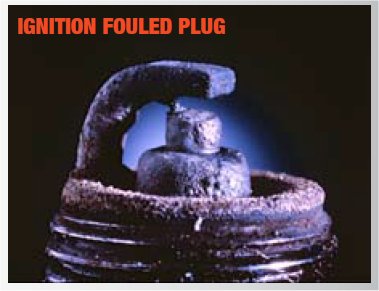
============================================
Examining the spark plugs that are removed from an engine can help you determine if the engine has problems that need to be corrected. Here’s what to look for.
Normal – Grayish-tan to white in color. No unusual signs of deterioration or coatings.

============================================
Red coating – Pinkish red coating on the ceramic insulator tip, center electrode and ground electrode. Sometimes spark plugs will have a slightly red coating, which is the normal result of additives used in some unleaded gasoline.

============================================
Worn out – The center and ground electrodes are eroded, have rounded edges and are excessively worn away. Difficulty starting the engine and misfiring during acceleration may occur. This indicates a spark plug that has been used beyond its intended service life.
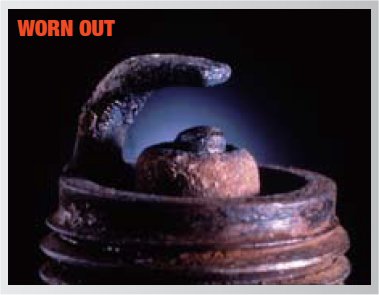
============================================
Fuel fouled – Firing tip may be damp with gasoline, and usually the odor of gasoline is present on the spark plug. The insulator is often tinted the color of charcoal. This indicates that gasoline is not being burned properly in this cylinder. Check for faulty or sticking choke, overly rich fuel mixture, ignition problems, leaking fuel injectors or a spark-plug heat range that is too cold.
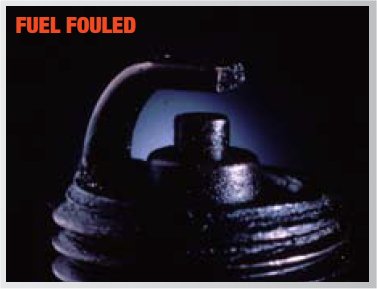
============================================
Oil fouled – Center electrode, ground electrode and/or ceramic insulator tip are coated with a black, oily substance. This is caused by the presence of oil in the combustion chamber. Check for worn rings, valve guides and/or valve seals. In two-stroke engines, this could be the result of high oil content in the fuel mixture.

============================================
Carbon fouled – Dried, soft black, sooty coating. There are a number of possible causes for this condition: Spark-plug heat range is too cold; extensive low-speed/short-distance driving; weak ignition system; rich fuel mixture; clogged fuel injectors; vacuum leaks; carbon canister/purge valve problems. Carbureted engines with carbon-fouled plugs may be improperly adjusted or have an improperly adjusted choke.

============================================
Lead fouled – Ceramic insulator tip is coated with a brownish-yellow glazed
coating. This condition occurs from the use of leaded fuel or fuel additives
containing lead.
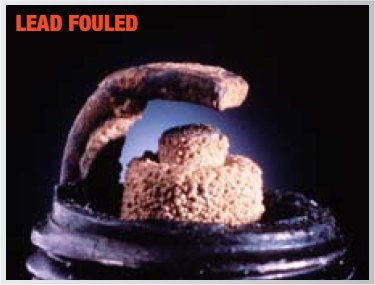
============================================
Glazing – Ceramic insulator tip appears to have a melted, glazed coating. Here the spark plug shows that the engine has been operating too hot at high speeds. These plugs should be replaced with a colder heat range.
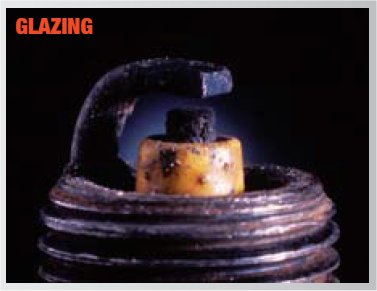
============================================
Detonation damaged – The insulator is usually cracked, chipped or broken, and the ground electrode may also exhibit damage. This spark plug exhibits signs of detonation, which can be caused by the use of low-octane gasoline or an overly advanced ignition timing. Check for a faulty EGR system, knock sensor and correct spark-plug heat range.

============================================
Sustained pre-ignition damage – Melted center and ground electrodes and damaged ceramic insulator tip. Sustained pre-ignition has noticeably damaged this plug. Check to be sure that the right specification of spark plug was used (heat range too hot or simply the wrong plug for this application). Also check for cross-firing of the ignition cables, overadvanced timing, lean fuel mixture, defective EGR valve, carbon deposits/ hot spots inside the combustion chamber due to poor heat dissipation, improperly torqued spark plugs when installed, or head gasket intrusion into the combustion chamber.

============================================
Physical damage – Center electrode and ground electrode are bent out of position. Ceramic tip is broken and missing. This is a serious condition caused by a possible foreign object inside the cylinder. Also check for the improper spark plug thread due to the use of the wrong spark plug for this application.
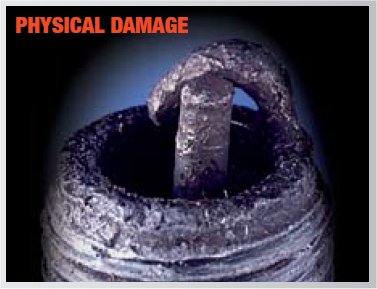
============================================
Ash deposits – Center electrode, ground electrode and/or ceramic insulator tip are coated with tan-colored deposits. This condition may be caused by the use of leaded gasoline, certain gasoline and/or oil additives. Also check for worn piston rings and/or valve guides. Misfiring may occur due to these deposits.
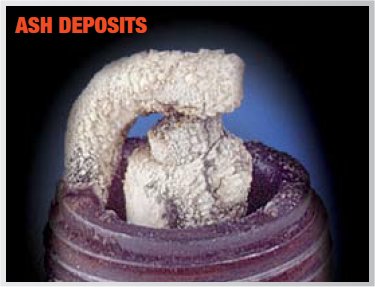
============================================
Corona stain – The insulator has a brownish-yellowish stain, usually just above the shell, but there are no apparent cracks or spark plug damage. This condition is caused by electromagnetic fields in the air around the engine. While it may look like a spark plug gas leak, it is not. There is no impact on spark plug performance.

============================================
Insulator breakage – Cracked or visibly broken ceramic insulator, usually caused by over-torquing the plug during installation or removal, or by dropping it on a very hard surface prior to installation. Will result in rough idle and misfires under load.
Flashover – Dark vertical lines and deterioration of the spark plug in the ribbed area of the insulator from a short between the metal spark plug shell and the terminal nut. Likely misfires. Can be caused by a variety of factors, including old/cracked spark plug boots, dirt or residue on the insulator, incorrect spark plug gap (too large) or even highly ionized air from an electrical storm.
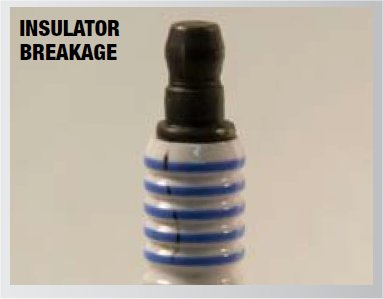
============================================
Troubleshooting Guide
Use the chart below as a general guideline when you have a spark plug recently removed from the engine to try to determine the root cause of engine running problems.

============================================
Spark Plug Example Matrix
You can use the chart below as a troubleshooting tool to initially diagnose spark plug heat range condition.
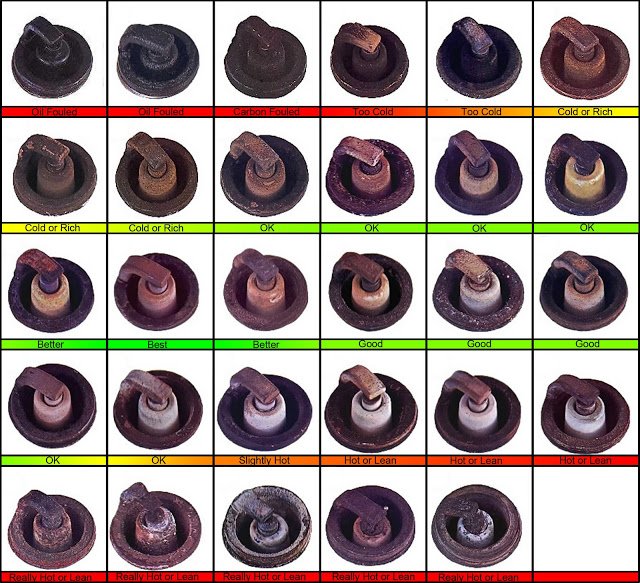
|